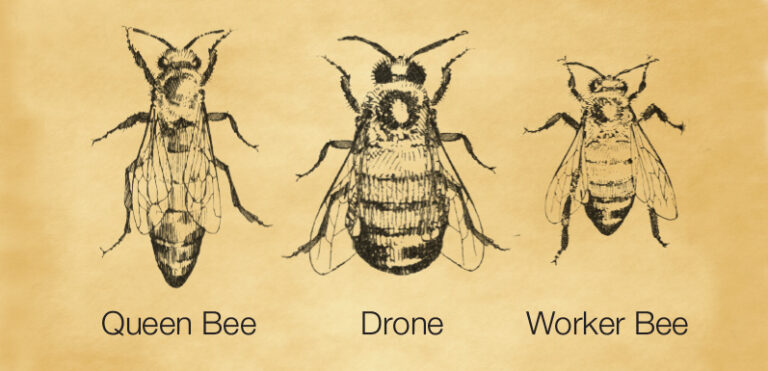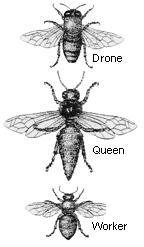Through the centuries, man has tried to solve the secrets responsible for the success of the honey bees. Only now are we beginning to lift the veil of mystery from the life of bees.
To successfully manage your bees, you must possess a basic understanding of what is happening in your hives. There is a division of labor in the hive according to the caste of the different types of bees, which establishes a hierarchy. The queen lays the eggs, workers do all the work and drones serve for fertilization of the virgin queen.
Understanding each individual bee’s role in the hive will help you understand how to manage a hive more efficiently. For the most part, we will focus on the worker bee, as it does most of the work. The queen and drones are there to mainly just reproduce.
The working phase of worker bees in time sequence
- Cell cleaning – from 1-25 days
- Feeding larvae – from 7-30 days
- Building activities including cappings – 1-32 days
Various Activities
Age does exert a strong influence on the division of labor for the individual bee, but the determining factor seems to be based upon the needs of the colony as a whole. A normal colony consists of bees of all ages, and there is a certain general sequence of work which the bees perform; however, this division of labor is very flexible, constantly changing according to the conditions inside and outside the hive.
Comb Building
In summer, a worker spends half of her life as a hive bee and the other half as a fielder. Beeswax is the material used by honey bees in the construction of their combs. It is the product of their own bodies secreted through a gland on the bottom of their abdomen. The wax glands on the worker bee reach the height of their development and productivity when the bee is about 12-18 days old. Wax can be secreted only at relatively high temperatures and only after the consumption of large amounts of honey or nectar. Workers actively engaged in secreting wax will gorge themselves on honey and hang out near the site of building operations. Wax scales are removed by the bee using her legs and mandibles that are fixed to the comb. The mandible glands secret a juice used in masticating the scales building combs.
Nursing
Young bees normally take up the work of nursing at the age of 3 days. Nurse bees begin to make visits to the cell as soon as the egg is laid and continues.
 Food Transmission
Food Transmission
In a colony of bees, food is passed from one worker to another and also from worker to the queen and drones. Both the act of begging for food and offering of food are instinctive reactions by honey bees and improve in precision with age. Food transmission is important for the cohesion of a colony. It also may serve as a form of communication for the bees by informing each other of the amount of food and water available. Bees need two types of food, both provided by nature. Yet these two foods, which are brought back to the hive by foraging bees, are so diametrically different from each other in nutrition and form that one cannot doubt the existence of an intelligent Creator — one is nectar, which is rich in sugar but mostly free of protein, and the other is pollen, which is very rich in protein.
Guard Duty
The hive entrance is a portal through which both friends and enemies can enter the hive. When very little nectar is available, the colony is constantly alert. Guard bees are persistently present at the entrance of the hive. Would-be robbers are intercepted and quite often stung to death. Apparently the guards recognize approaching bees by smell to determine if they are a friend or enemy of the hive.
Robbers
Robbers can be recognized by their peculiar flying to-and-fro in front of the hive entrance. This behavior of robber bees is an innate response. Other bees recognize them by a combination of behavior and smell.
Fanning
In the warm weather, bees reduce the temperature within the hive by fanning at the entrance. During the honey flow season, the air currents set up within the hive hasten the elimination of excess moisture from unripe honey in the open cells.
Habits of Field Bees
Activities involving flight sometimes begin as early as the third or fourth day of a bee’s life but normally takes two weeks before foraging trips are made. Field bees become familiar with plants and will only gather from that species of plant as long as food is available. When that floral species near the hive runs out of food, they will find a new plant species. It is generally agreed that an individual bee works in a restricted area of the field. She may be attached to a particular group of plants or a single plant. The speed of the work depends on the type of plant. A normal field bee can visit up to 42 flowers in sweet clover per minute for example. They travel about 13-16 mile per hour when flying.
Homing Instinct
Bees of a colony moved from their old location to a new place will mark the location of the new hive on their first flight. As they fly out they will apparently take a survey of all the surroundings adjoining their home. The circles become larger and larger until they are lost to sight. If the hive is moved a few feet, the bees that have so thoroughly and so carefully marked the location will fly to the old spot and cluster on the ground. Yellow bees, especially Italians, would form a cluster on the spot where the old hive stood and starve to death unless there was another hive within a few inches of where the old hive stood.
Other Characteristics
It’s survival of the fittest! Old bees are dying all the time. Colony odor and queen odor– bees can tell when a new queen enters the hive. Bees are red blind. Red flowers are rare, but not in America. Red flowers only get pollinated by insects and butterflies, not bees.


 Food Transmission
Food Transmission